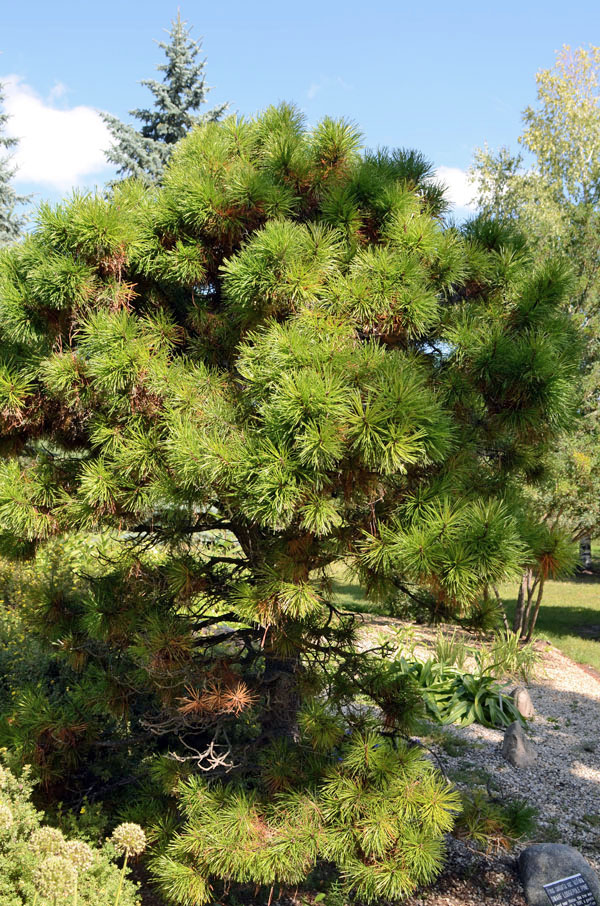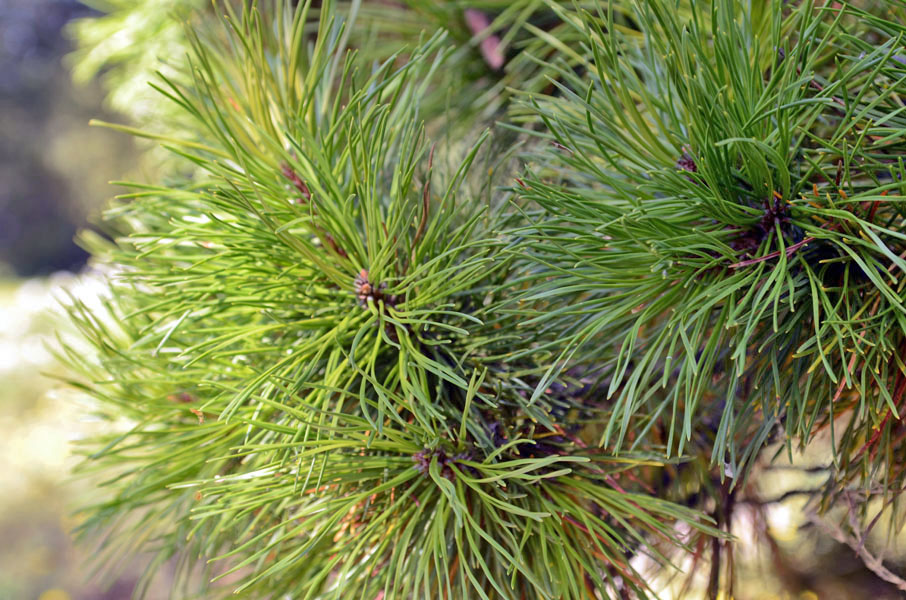
Woody > Pinus > Pinus contorta > Pinus contorta var. latifolia
Pinus contorta
var. latifolia
Lodgepole Pine
Origin: Distributed throughout western North America and common throughout British Columbia, Alaska, Yukon Territories, southwest Northwest Territories, Alberta, California, Utah, Colorado, and South Dakota. The species often hybridize with P. banksiana.

"
Lodgepole pine is one of the most widely distributed tree species in western North America, so it's no surprise that it is quite adaptable and has highly variable characteristics throughout its wide range. Its common name 'lodgepole' pine originated from the use of this tree for poles as supports and framing for tepees and lodges of the First Nation inhabitants. It hybridizes with Jack Pine (Pinus banksiana) and frequently exhibits physical characteristics with it in locations where populations of the species converge with each other. Lodgepole Pine has also been known to sometimes exhibit the thicker bark, and complete non-resinous cone characteristics of Shore Pine (Pinus contorta var. contorta) in some populations. There are a few dwarf cultivars of Lodgepole Pine available for ornamental use, such as Chief Joseph, though they are rare to infrequent in the landscape industry. Lodgepole pine is the provincial tree of Alberta, Canada.
Michael Pascoe, NDP., ODH., CLT., MSc. (Plant Conservation)
"
| Family |
| Pinaceae |
| Genus |
| Pinus |
| Species |
| contorta |
| Category |
| Woody |
| Type |
| Tree (evergreen) |
| Variety |
| latifolia |
| USDA Hardiness Zone |
| 3 - 8 |
| Canadian Hardiness Zone |
| 4a - 9 |
| RHS Hardiness Zone |
| H7 |
| Temperature (°C) |
| - 46 |
| Temperature (°F) |
| - 50 |
| Height |
| 13 - 45 m |
| Spread |
| 3 - 6 m |
| General Description |
| It is a tall columnar tree with a narrow conical crown. Bark texture and colour, as well as needle colour are variable between trees. The overall tree is rather rugged in appearance. |
| Landscape |
| Normally mass planted for use in the lumber industry. It makes a decent specimen tree when young; however, rapid growth and occasionally rugged appearance limits its usefulness. Dwarf cultivars of this tree used as ornamentals in the landscape would fill the niche better in the long run. It can also be used as a vertical accent, small groupings, and for windbreaks and shelterbelts; although, it may need plantings of medium to low growing shrubs to cover the lower trunk. |
| Cultivation |
| Adaptable to a variety of soil conditions but prefers a soil pH between 6.2 and 7.5 with medium fertility and moisture. It is not particularly tolerant of alkali soils and is intolerant of shade. It has high tolerance to poor rocky soils and a moderate tolerance to drought. |
| Shape |
| A tall straight, columnar tree with a crown that is narrowly conical and a trunk that is often straight with little taper. |
| Growth |
| Fast |
| ID Characteristic |
| The wide variability within the species may cause confusion in identification but its tall columnar form, flattened, long densely arranged needles, thin bark, and semi-spiny cones are its distinct and consistent features throughout. Pinus contorta var. latifolia has more flexible needles, thinner bark, and a taller more columnar form than Pinus contorta var. contorta. Needles are also longer than either Pinus banksiana or Pinus contorta var. contorta. Seed cones are thickened at their tips and sometimes possess curved spines; unlike Pinus banksiana, which has much less thickened scale tips and rarely possess spines, having smaller more inconspicuous spines compared to the former species. Also, Pinus banksiana cones point towards the tips of the branches, while Pinus contorta var. latifolia cones point towards the base of the branches. |
| Pests |
| Various bark beetles (Dendroctonus sp.) are serious pests. They tunnel under the bark of more mature trees where they lay eggs. As the tree dies, the needles change from green to a rusty-brown colour. Comandra Blister Rust (Cronartium comandrae) forms cankers on the stems that may prove fatal to the tree. Other pests include Pandora Moth (Coloradia Pandora), Pitch Twig Moth (Retinia albicapitana), Lodgepole Needle Miner, Jack Pine Budworm (Choristoneura pinus), Rocky Mountain Lodgepole Pine Terminal Weevil, and Mistletoe (Arceuthobium americanum). |
| Habitat |
| It occurs on a wide range of sites and soils including wet to dry bogs, lower slopes, high river terraces in the lowland, and montane to subalpine zones. Most forests with the species are of fire origin and large pure stands are common, especially on poorer sites and localities with frequent forest fires. |
| Bark/Stem Description |
| Bark is thin, grey to red or orangey-brown with fine scales to loose round square-shaped plates. Not evidently furrowed but sometimes fissured into the square shapes on the bark. Bark on young branches begins knobby and scaled only to become smooth, and then eventually scaly like the bark on the mature trunk. |
| Flower/Leaf Bud Description |
| Buds are blunt-pointed, up to 1.5 cm long, reddish-brown, and resinous. On vigorous shoots, buds are often polycyclic. |
| Leaf Description |
| Lodgepole pine has evergreen foliage with 2 needles per fascicle (or in rare cases 3 in some small populations) with a bundle-sheath present that becomes simpler with age. Needles are 3-8 cm long and moderately wide. They are stiff with some flex and usually twisted. Needle tips are sharply-pointed, and the side edges of the needles are finely toothed (not visible but can be felt by stroking the needle edges backward). Needles are densely arranged on the branches of the tree. Colour ranges from dark green, to blue green, to yellow green, and may display faintly visible dark 4-5 veins/ridges along the flat sides of the needle. Pinus contorta var. contorta has shorter, stiffer needles than Pinus contorta var. latifolia. |
| Flower Description |
| Monoecious, pollen cones are upright oblong clusters that are 8-10 mm long and are cadmium orange to yellow coloured. Female flowers are tiny and reddish-brown. Borne on the young shoots in late spring, although somewhat attractive in appearance, they are somewhat inconspicuous on the tree. |
| Fruit Description |
| Cone size, shape, and serotiny are variable throughout its range. Ovoid to cylindrical/oblique in overall shape and are 2-6 cm long and stalkless. The cone scales are thickened at their tips, sometimes possessing curved spines. The cones are placed in small clusters at the nodes of the branches with the cones themselves projecting or reflexing with a right angle toward the base of the branch. Semi-erect cone placement may suggest previous hybridization with Pinus banksiana in its ancestry. The cone of Pinus contorta var. latifolia may be asymmetrical, especially when it comes to the symmetry of spine placement around the cone. They are pale-brown to grey colour on the exterior of the cone and pale warm brown to black purplish-brown on the interior. The cones are usually held by a resin bond and stay closed on the tree for 10-20 years only to open when exposed to the heat from a wildfire or from direct sunlight. On average, the tree produces a ratio of 1:1 between serotinous and non-serotinous cones, though younger trees often produce more non-serotinous cones than mature trees. Seeds are brownish, often mottled and ridged on one side, 3-5 mm long with wings about 18-16 mm long. |
| Colour Description |
| Cadmium orange to yellow coloured male cones. Pale-brown to grey seed cone exteriors contrasted with pale warm brown to black purplish-brown on the cone interiors. Bark is grey to red or orangey-brown. Needle colour ranges from dark green, to blue green, to yellow green. Needle and bark colour are the most notable colour features. |
| Texture Description |
| The needles and bark give it a heavy to airy coarse texture. |
| Notable Specimens |
| The Devonian Botanic Garden, Devon, Alberta, Canada. University of Guelph Arboretum, Guelph, Ontario, Canada. Dominion Arboretum, Ottawa, Canada. Arboretum de Villardebelle, Aude, Languedoc-Roussillon, France. Rog'w Arboretum, Poland. Numerous notable specimens may also be found along its native range of western North America. |
| Propagation |
| Grafting, cuttings, and layering are possible, although success varies between trees. It is more common and viable to be propagate by seed, despite genetic variation and potential to hybridize with local Pinus banksiana trees. For seed, cones are collected in early September, the serotinous cones are heated in kilns (heated at 45 - 50°C) or placed in boiling water, and then air-dried to facilitate opening of the cones for seed collection. Non-serotinous cones are often opened via heat from direct sunlight. Seeds can be sowed non-stratified but stratification will result in more germination vigor and uniformity in the material. For pretreatment, seeds are treated with 8:1 water/bleach bath for 10 minutes followed by a 48 hour running water rinse soak and a 45 day cold moist stratification. For the stratification, the seeds are placed in fine mesh bags in moist peat moss and buried in ventilated containers at 3�C. The seeds are directly seeded. Stratified seeds are lightly covered with medium as the germination rate is higher in darkness, while non-stratified seeds germinate better with light. Seeds must not be sown or covered too deeply. The growing media that the seeds are sown in is 6:1:1 milled sphagnum peat, perlite, and vermiculite. The initial germination is typically completed in 20 days. |
| Ethnobotanical Uses (Disclaimer) |
| Its fast growth and straight trunk see it commonly used in commercial forestry for timber. Some examples of its use include general construction and wood pulp; after treatment with preservatives, it is also used for railway ties, poles, and mine timbers. It has also been tested as a commercial timber tree outside its native range in places like Sweden. When treated with a preservative the wood may be used in decking, fence posts, rails, railway ties and utility poles. |

